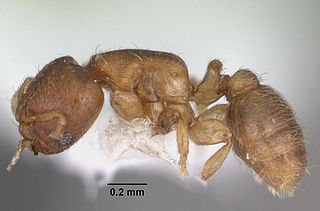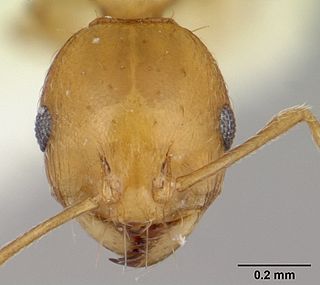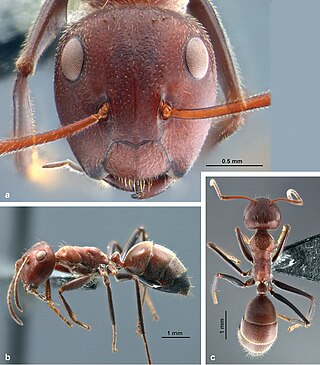
Myrmicinae is a subfamily of ants, with about 140 extant genera; their distribution is cosmopolitan. The pupae lack cocoons. Some species retain a functional sting. The petioles of Myrmicinae consist of two nodes. The nests are permanent and in soil, rotting wood, under stones, or in trees.

Myrmarachne is a genus of ant-mimicking jumping spiders that was first described by W. S. MacLeay in 1839. They are commonly called ant-mimicking spiders, but they are not the only spiders that have this attribute. The name is a combination of Ancient Greek μύρμηξ, meaning "ant", and ἀράχνη, meaning "spider".

Aphaenogaster is a genus of myrmicine ants. About 200 species have been described, including 18 fossil species. They occur worldwide except in South America south of Colombia, sub-Saharan Africa, and Antarctica.

Crematogastrini is a tribe of myrmicine ants with 64 genera and 8 fossil genera.

Myrmoteras is a genus of ants in the subfamily Formicinae and the sole member of the tribe Myrmoteratini. They have enormous eyes, a character found in other ancient genera, and extremely elongated mandibles with eight to 16 teeth. These work as trap-jaws and can open up to 270°.

Leptanilla is a genus of ant in the subfamily Leptanillinae. Like other genera in this subfamily, the queen is fed by the hemolymph of their own larvae, which have specialized processes for this purpose.

Aenictus is a large army ant genus distributed in the Old World tropics and subtropics. It contains about 181 species, making it one of the larger ant genera of the world.

Myrmecina is a genus of ants in the subfamily Myrmicinae. It contains 53 species distributed in North America, Europe, northern Africa, India, Korea, Japan and Australia.

Aenictus brevipodus is a species of ant in the Dorylinae subfamily. It was first described in 2013 by Weeyawat Jaitrong and Seiki Yamane.

Probolomyrmex is a genus of ants in the subfamily Proceratiinae. The genus is distributed throughout the tropics and subtropics. The ants are very rare, and are rarely collected in the field, but they appear to be nesting in the leaf litter or in rotten wood. Little is known about their biology.

Vollenhovia is a genus of ants in the subfamily Myrmicinae.

Rhopalomastix is a genus of ants in the subfamily Myrmicinae. It is restricted to the Oriental and Indo-Australian regions, where the ants nest under the bark of living trees.

Cladomyrma is a genus of ants in the subfamily Formicinae. The genus is restricted to the Malay Peninsula, Borneo, and Sumatra. All known Cladomyrma species build their nests on live stems.
Aenictus gutianshanensis is a Chinese species of army ant in the genus Aenictus. The species is known only from a single colony. Little is known about its biology, but it is probably most closely related to A. vieti.

Brachyponera is a genus of ants in the subfamily Ponerinae.

Aenictus gracilis is a species of reddish brown army ant found in Borneo, Indonesia, Malaysia, Philippines, Bangladesh, India, Myanmar, and Sri Lanka.
Technomyrmex horni is a species of Dolichoderine ant which is a widespread species that can be found in many Indo-Australian, Oriental, and Palaearctic regions.

Recurvidris browni is a species of ant of the subfamily Myrmicinae, which can be found from Indonesia (Kalimantan), Malaysia and Thailand. The size of the ant is about 2.50–2.60 mm. Its body colour is yellow.

Colobopsis explodens is a species of ant which is found in Southeast Asia. Like some other species in its genus, it is noted for a rare combat mechanism of workers exploding in self-defense, smothering the enemy with toxic and often deadly secretion. This suicidal defensive adaptation also occurs among some species of termites: it is termed autothysis, and as ants and termites are members of practically unrelated insect orders, it comprises a dramatic example of convergent evolution.

















